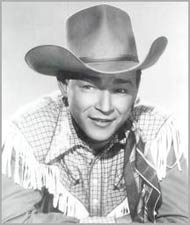
A top Singing Cowboy: Roy Rogers’ real name was Leonard Franklin Slye. He lived in Ohio with his family up until the time he became intrigued with California after visiting his newly married sister there.
Roy had already become a proficient yodeler and practiced endlessly (he was a fan of Jimmie Rodgers). He worked as a truck driver and migrant farm worker. He entered an amateur program and sang and played banjo and mandolin with his cousin.
Roy was then invited to sing in the group “Rocky Mountaineers” which was appearing on a radio station. But, he wanted to do duets and thus advertised for another yodeler to join the group. Singers Bob Nolan and Bill “Slumber” Nichols joined with him and pretty soon they became the first trio of yodelers. Nolan was later replaced by Tim Spencer but the group broke up in 1933 then reformed a while later as “The Sons of the Pioneers”.
The group performed successfully on a Los Angeles radio station from 1934-36. In 1937, when he heard Republic was auditioning singers to replace Gene Autry who was having contract disputes, Roy sneaked onto the studio after a guard wouldn’t let him enter. He was rescued by a producer who recognized the young singer and signed to a contract that began his career. His name was immediately changed to Roy Rogers, although Rogers himself did not legally change it until 1942.
He went from cowboy in early films to singing cowboy “Roy Rogers, in gaudy clothing, his horse Trigger, dog Bullet, and female lead Dale Evans. He and Dale Evans made 20 pictures together and they were married in 1947, a year after Roger’ first wife died after giving birth. Roy had his own radio show in 1944, another one in 1946 and another one in 1948 which lasted three years.
Then came his NBC radio show (1951-1954) in which he and Dale sang and Gabby Hayes, Pat Buttram and Pat Brady provided comic relief. Rogers’ TV show “The Roy Rogers Show” with its 30 minute episodes proved a great success. Trigger died in 1965 at the age of 33 and was stuffed and placed in Rogers’ Victorville, California museum. Rogers himself passed away in 1998.





